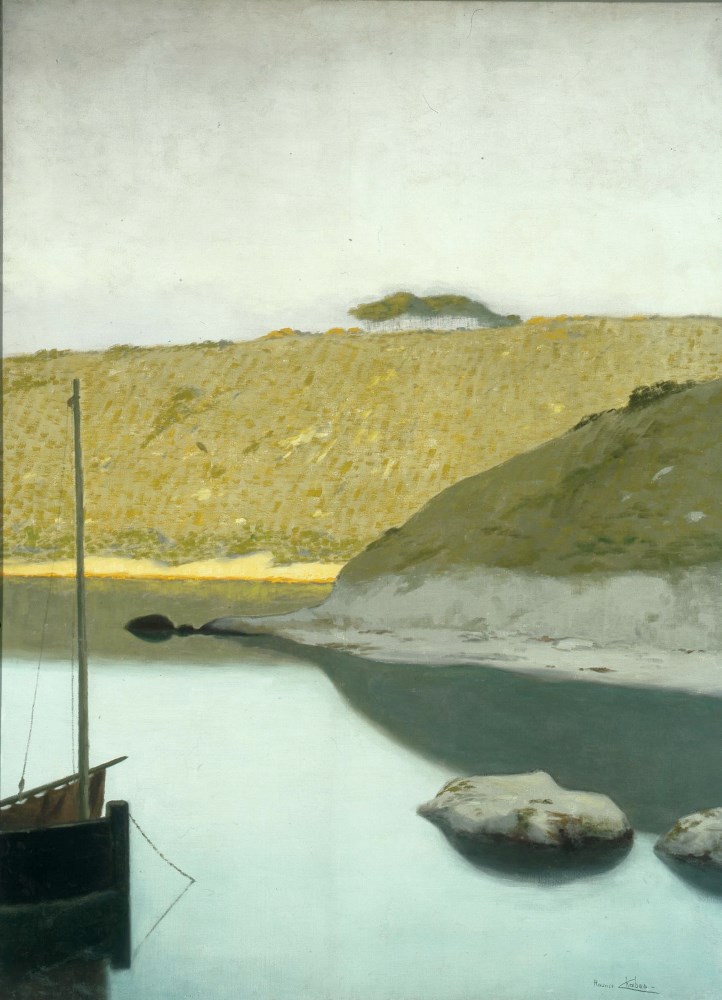Description:
“I will always remember him with his hat pulled down over his eyes, his head held high, his beard blowing in the wind, savoring the soul of the landscape, of this land, this water, this sky, which he brought to life with the magician’s touch of his fingers.”[1]
Maurice Chabas (1862-1947) was a French painter, brother of Paul Chabas. He started with Symbolism, then became fascinated by Neo-Impressionism, Synthetism and Abstractionism. He inherited his passion for painting from his father, Oscar. From 1883 to 1888 he attended the Julian Academy in Paris. He was a representative of the Triennale, Secretary General of the Société Idéaliste, a member of the French Astronomical Society and President of the Modernist Society. In order to support cultural creators, he founded the Society of Friends of Artists [2]. From 1892 to 1897 he exhibited at the Rose-Croix (Rosicrucian) movement presentations, of which he was a member and defender. He exhibited his works at the Salon des Artistes Français and the Salon de Société Nationale des Beaux-Arts. He painted wall decorations, portraits and allegorical paintings. He was inspired by the works of Puvis Chavannes and Maurice Denis “both in the synthetic way of treating large planes of the picture, as well as in the theme with a symbolic character”. [3].
“For Chabas, art is a spirit that naturally accompanies his creativity. Line, form and color express symbolic mystical connections between spirit and matter. For idealists, art is a memory of what is divine” [4]. He therefore relentlessly searches for this ideal beauty [5]. Pure materialism means degradation of art for him. In addition to what is only visible, each work should refer us to the sphere of inner life, reaching far beyond the image. Quoting the artist: “Any form, perceived in physical dimension, is a certain state of consciousness and we build our future form with every beat of the heart, through our deepest thoughts. Therefore, since everything is vibration, an artistic or literary work cannot escape this law of life. On the contrary, it has an extraordinary power of suggestion … it has radiation, from which it is impossible to escape. “[6].
In the Rogalin Gallery there are two works of Maurice Chabas. The painting “Peace in Nature” may be a kind of pendant to the presentation entitled “Reverie”. On both canvases, the artist portrayed the Aven River [7]. The diptych thus takes us to the rocky coasts and numerous coves of Brittany. The painter captured on the painting a fragment of an island located in the middle of the river and part of the coast covered with sparse vegetation in its diversity. Everything seems to be shrouded in a delicate, dreamy milky glow. The blue of the immovable depths of the water harmonizes perfectly with the soiled white and gray of the sky. The composition of the presentation is very synthetic, with not very diverse colors. Almost mystical. Chabas limited himself to just a few shapes, whose contours complement each other. The clear vertical accent remains the mast of the boat framed on the left side of the picture field. It is the only dissonance in the whole compositional presentation. As a result, it encourages the recipient to search for its completion and meaning.
The all-encompassing silence and the dominating power of nature in the representation puts the viewer in the position of a mute observer of the infinity of its forces. On the one hand, it expresses fascination with its ubiquity, on the other hand – admiration and desire to participate in the boundlessness emanating from it peace and harmony. The title “peace” can therefore be referred not only to the environment, ie the peaceful image of nature, but also – and perhaps above all – to the feeling of peace that this environment, or more precisely the pictorial representation of nature, evokes in the viewer. The expressive aspect of the presentation becomes particularly important here. It causes an alliance between the artist and the observer, whose reception actually co-creates the work. It is the viewer who constitutes its content and meaning on a level other than just material consciousness. It transfers its interpretation to the realm of spiritual life. So different, yet permanently and harmoniously combined with the part of the real world, the world of the life of nature, in which and with which it was created. It is in its environment that we find inner peace, a trace of the divine element of creation.
According to Chabas, art is about “understanding nature”, approaching its ideal of beauty. The only guide to its secret paths is the artist, the creator, who “is… a messenger between the divine world and the human world. His task, as a visionary perceiving the invisible, is to spread beauty.”


